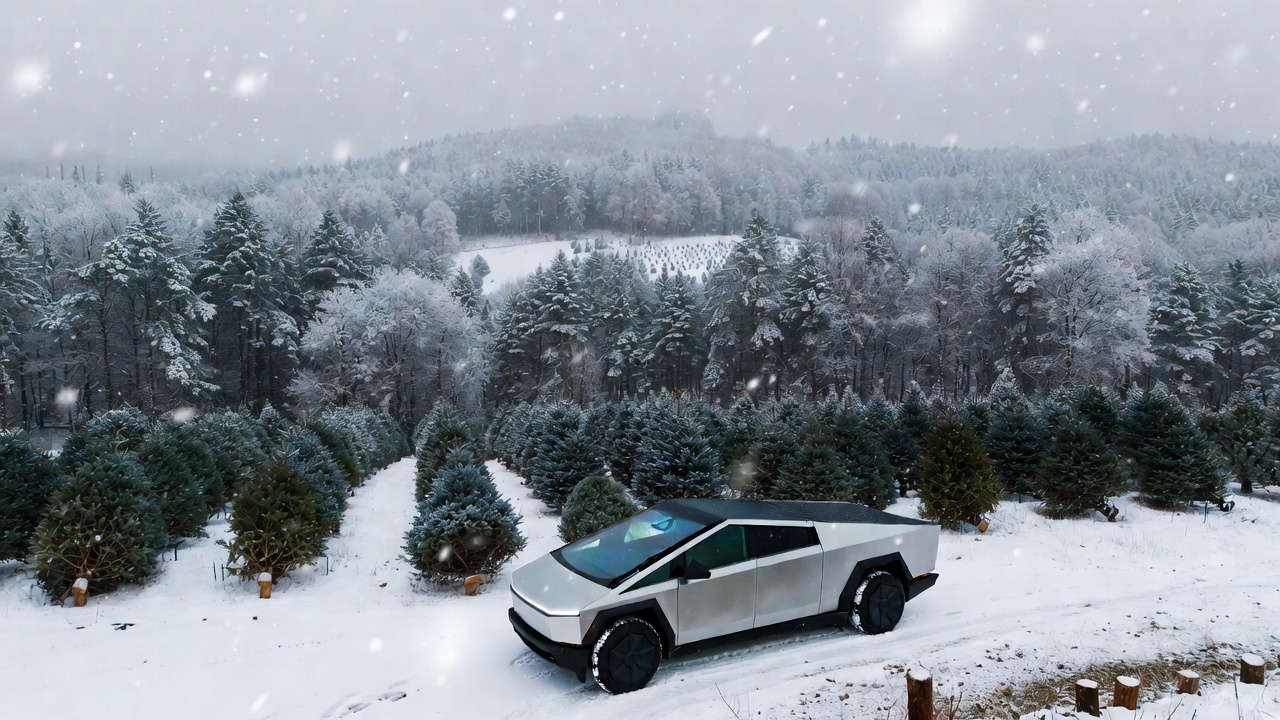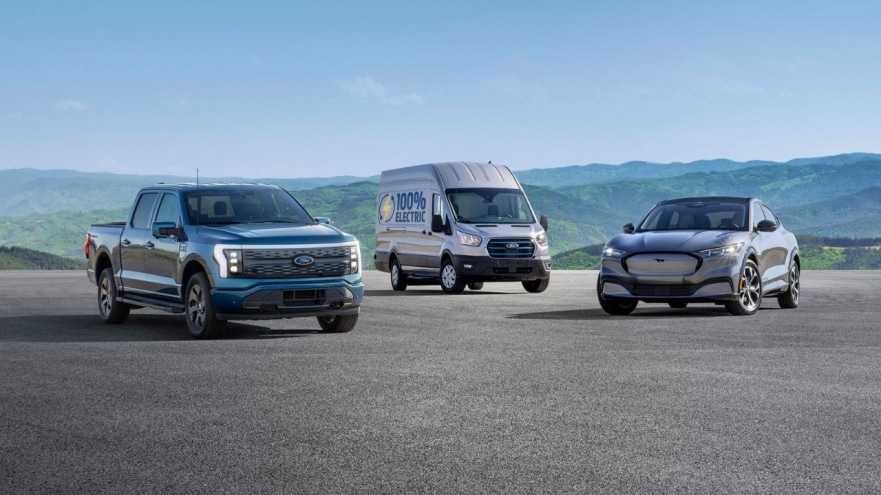Ford has announced a massive EV production ramp for this year, leveraging its head start compared to its traditional rivals.
Despite Ford entering the EV market significantly behind Tesla and even lagging General Motors, its vehicles have quickly overtaken its traditional rivals, making the Blue Oval the second most popular EV brand in the United States. Now Ford has announced its newest EV production ram, hoping to ensure its lead remains as more competitors enter the market in the coming years.
The latest EV production ramp aims to increase the production of Ford’s most popular models. The Ford Mustang Mach-E, the electric SUV which helped cement Ford’s EV lead after launching in 2021 and remains the brand’s most popular EV, receives the most substantial bump, while the F-150 Lightning and E-Transit subsequently receive more minor production bumps.
The production ramp of the Mustang Mach-E began last week and aims to double hourly production, with a year-end goal of an annual run rate of 210,000 vehicles. The F-150 Lightning, which will resume production on the 13th of this month, aims to triple annual production, an annual run rate of 150,000 vehicles, by the end of the year. The truck’s production ramp costs $2 billion across three Ford production facilities in Michigan, including its main production facility, the Rouge EV Center.
The E-Transit receives a more conservative production bump, aiming for an annual run rate of 38,000 vehicles at the Kansas City Assembly Plant, which manufactures the Transit and the E-Transit vans.
Other popular models, including the Ford Maverick and the Ford Bronco Sport, are also receiving production ramps to help the Blue Oval stay ahead of demand for the popular, affordable models.
Ford’s latest electric vehicle production push is part of its larger plan to reach an annual run rate of 2 million vehicles by 2026.
The production bump follows Ford’s recently announced sales statistics for February, in which its EV sales jumped by 68%, helping the company grow its overall marketshare by 1.4%.
Ford’s aggressive EV production ramp only becomes far more apparent when compared to its big-three siblings. General Motors, who beat Ford to the EV market with the popular Chevy Bolt model, has yet to introduce competitors to Ford’s Mustang Mach-E or F-150 Lighting and expects to begin production of its Chevy Silverado EV late this year. Those looking for a mid-size electric SUV from GM, such as the Chevy Equinox EV or Blazer EV, are forced to wait even longer, with both models coming sometime in 2024.
This isn’t to say that GM doesn’t have a production ramp planned at all. General Motors CEO Mary Barra has outlined that the auto group will produce 400,000 EVs “in North America during 2022 and 2023.” However, model-specific production numbers have not yet been published.
Stellantis brands are even further behind. RAM plans to introduce its first all-electric truck, the RAM 1500 REV, in 2025. Dodge has yet to reveal any EVs in a production-ready form. And Jeep, while recently introducing its first EV to Europe, is only slightly ahead of its sibling brands, with the first Jeep EVs coming to North America in 2025 as well.
Ford is set to remain a leader in electrification, at least compared to the other big three manufacturers, and potentially globally, and this significant EV production ramp will likely be critical to maintaining that position.
What do you think of the article? Do you have any comments, questions, or concerns? Shoot me an email at william@teslarati.com. You can also reach me on Twitter @WilliamWritin. If you have news tips, email us at tips@teslarati.com!

Elon Musk
Starlink passes 9 million active customers just weeks after hitting 8 million
The milestone highlights the accelerating growth of Starlink, which has now been adding over 20,000 new users per day.

SpaceX’s Starlink satellite internet service has continued its rapid global expansion, surpassing 9 million active customers just weeks after crossing the 8 million mark.
The milestone highlights the accelerating growth of Starlink, which has now been adding over 20,000 new users per day.
9 million customers
In a post on X, SpaceX stated that Starlink now serves over 9 million active users across 155 countries, territories, and markets. The company reached 8 million customers in early November, meaning it added roughly 1 million subscribers in under seven weeks, or about 21,275 new users on average per day.
“Starlink is connecting more than 9M active customers with high-speed internet across 155 countries, territories, and many other markets,” Starlink wrote in a post on its official X account. SpaceX President Gwynne Shotwell also celebrated the milestone on X. “A huge thank you to all of our customers and congrats to the Starlink team for such an incredible product,” she wrote.
That growth rate reflects both rising demand for broadband in underserved regions and Starlink’s expanding satellite constellation, which now includes more than 9,000 low-Earth-orbit satellites designed to deliver high-speed, low-latency internet worldwide.
Starlink’s momentum
Starlink’s momentum has been building up. SpaceX reported 4.6 million Starlink customers in December 2024, followed by 7 million by August 2025, and 8 million customers in November. Independent data also suggests Starlink usage is rising sharply, with Cloudflare reporting that global web traffic from Starlink users more than doubled in 2025, as noted in an Insider report.
Starlink’s momentum is increasingly tied to SpaceX’s broader financial outlook. Elon Musk has said the satellite network is “by far” the company’s largest revenue driver, and reports suggest SpaceX may be positioning itself for an initial public offering as soon as next year, with valuations estimated as high as $1.5 trillion. Musk has also suggested in the past that Starlink could have its own IPO in the future.
News
NVIDIA Director of Robotics: Tesla FSD v14 is the first AI to pass the “Physical Turing Test”
After testing FSD v14, Fan stated that his experience with FSD felt magical at first, but it soon started to feel like a routine.

NVIDIA Director of Robotics Jim Fan has praised Tesla’s Full Self-Driving (Supervised) v14 as the first AI to pass what he described as a “Physical Turing Test.”
After testing FSD v14, Fan stated that his experience with FSD felt magical at first, but it soon started to feel like a routine. And just like smartphones today, removing it now would “actively hurt.”
Jim Fan’s hands-on FSD v14 impressions
Fan, a leading researcher in embodied AI who is currently solving Physical AI at NVIDIA and spearheading the company’s Project GR00T initiative, noted that he actually was late to the Tesla game. He was, however, one of the first to try out FSD v14.
“I was very late to own a Tesla but among the earliest to try out FSD v14. It’s perhaps the first time I experience an AI that passes the Physical Turing Test: after a long day at work, you press a button, lay back, and couldn’t tell if a neural net or a human drove you home,” Fan wrote in a post on X.
Fan added: “Despite knowing exactly how robot learning works, I still find it magical watching the steering wheel turn by itself. First it feels surreal, next it becomes routine. Then, like the smartphone, taking it away actively hurts. This is how humanity gets rewired and glued to god-like technologies.”
The Physical Turing Test
The original Turing Test was conceived by Alan Turing in 1950, and it was aimed at determining if a machine could exhibit behavior that is equivalent to or indistinguishable from a human. By focusing on text-based conversations, the original Turing Test set a high bar for natural language processing and machine learning.
This test has been passed by today’s large language models. However, the capability to converse in a humanlike manner is a completely different challenge from performing real-world problem-solving or physical interactions. Thus, Fan introduced the Physical Turing Test, which challenges AI systems to demonstrate intelligence through physical actions.
Based on Fan’s comments, Tesla has demonstrated these intelligent physical actions with FSD v14. Elon Musk agreed with the NVIDIA executive, stating in a post on X that with FSD v14, “you can sense the sentience maturing.” Musk also praised Tesla AI, calling it the best “real-world AI” today.
News
Tesla AI team burns the Christmas midnight oil by releasing FSD v14.2.2.1
The update was released just a day after FSD v14.2.2 started rolling out to customers.

Tesla is burning the midnight oil this Christmas, with the Tesla AI team quietly rolling out Full Self-Driving (Supervised) v14.2.2.1 just a day after FSD v14.2.2 started rolling out to customers.
Tesla owner shares insights on FSD v14.2.2.1
Longtime Tesla owner and FSD tester @BLKMDL3 shared some insights following several drives with FSD v14.2.2.1 in rainy Los Angeles conditions with standing water and faded lane lines. He reported zero steering hesitation or stutter, confident lane changes, and maneuvers executed with precision that evoked the performance of Tesla’s driverless Robotaxis in Austin.
Parking performance impressed, with most spots nailed perfectly, including tight, sharp turns, in single attempts without shaky steering. One minor offset happened only due to another vehicle that was parked over the line, which FSD accommodated by a few extra inches. In rain that typically erases road markings, FSD visualized lanes and turn lines better than humans, positioning itself flawlessly when entering new streets as well.
“Took it up a dark, wet, and twisty canyon road up and down the hill tonight and it went very well as to be expected. Stayed centered in the lane, kept speed well and gives a confidence inspiring steering feel where it handles these curvy roads better than the majority of human drivers,” the Tesla owner wrote in a post on X.
Tesla’s FSD v14.2.2 update
Just a day before FSD v14.2.2.1’s release, Tesla rolled out FSD v14.2.2, which was focused on smoother real-world performance, better obstacle awareness, and precise end-of-trip routing. According to the update’s release notes, FSD v14.2.2 upgrades the vision encoder neural network with higher resolution features, enhancing detection of emergency vehicles, road obstacles, and human gestures.
New Arrival Options also allowed users to select preferred drop-off styles, such as Parking Lot, Street, Driveway, Parking Garage, or Curbside, with the navigation pin automatically adjusting to the ideal spot. Other refinements include pulling over for emergency vehicles, real-time vision-based detours for blocked roads, improved gate and debris handling, and Speed Profiles for customized driving styles.










